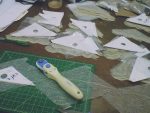Hey everyone. Just wanted to take a moment to introduce myself and the new series of posts I’m working on for the BTS Blog. When I’m not working on BTS with Layla I have a day job working as an environmental lawyer. In an ongoing series posts I’m going to talk about sustainability in fashion and why supporting fair wages and made in the USA fashion is so important. These topics are near and dear to Layla and I and bring together my BTS and environmental lawyer worlds. Join in the conversation in the comments or make suggestions for future posts on sustainable manufacturing and fashion. Hope you enjoy!
Part 1: Fast Fashion is like fast food—it may be easy to consume, but it tends to leave a bad taste in your mouth.
It may surprise you, but when I’m not busy helping to share beautiful lingerie and loungewear with all of BTS’s fans I am an environmental lawyer working to protect New York’s waterways. When Layla and I embarked on this journey to launch Between the Sheets I wouldn’t have imagined that my work as an environmental lawyer and a lingerie entrepreneur could be so intertwined. I consider myself to be fairly savvy when it comes to environmental issues, but I was shocked to learn recently that the global textile industry is one of the biggest polluters of our precious waterways around the world. When you think of environmental impact you are far more likely to think of oil giants such as BP or Exxon or maybe dirty coal power plants or the mining industry. In fact if you look at China and other countries where much of the throw away clothing that sits on racks at big chain stores comes from, the textile industry, which is the lifeblood of apparel manufacturing, is one of the worst polluters.
If you’ve seen the Movie Supersize Me, where Morgan Spurlock ate nothing but McDonalds for 30 days and saw his health plummet rapidly, you’ve seen the horrifying health effects of a constant diet of fast food. Fast fashion, is easily consumed, cheap, and abundantly available, and has similar impacts to the areas of the planet where cheap throwaway apparel is born. In China coal fired boilers belch thick black smoke, heating dye bathes where fabric is dyed. These dyes and other harsh chemicals used in the finishing and treating of fabrics make their way into the rivers and pollute water, ground, and air. A recent CNN news story explored the impacts of the denim industry in China and in September 2010 pollution concerns triggered a shutdown by the Chinese government of half of the textile dye houses in the Eastern textile hub of Zhejiang.
Fast fashion is a global business with design done in one country, raw materials sourced from all over the globe, and manufacturing done in the countries with the cheapest labor. The spreading global network of supply and manufacturing may be cheaper, but the green house gases of transportation and lax environmental oversight in many countries make this global model of production environmentally costly.
Like a gourmet meal prepared from local organic ingredients, Between the Sheets and others who have made a commitment to manufacturing in the United States and sourcing environmentally friendly and sustainable materials go about making clothing from a very different perspective. Between the Sheets sources our materials from US and European suppliers where strict environmental laws protect what can be released into our waters and air, ensuring that the impact is minimized and our environment is protected. Souring materials and manufacturing closer to home also reduces the impact of transporting raw goods and components and spreading manufacturing all over the world.
Most people don’t eat gourmet food all the time and by the same token often find themselves buying fast fashion that has been made overseas. Thanks to the efforts of the Natural Resources Defense Council (NRDC), the Clinton Global Initiative and some of the largest buyers of imported fast fashion (H&M, Walmart, and others) efforts are being undertaken to make the global apparel industry greener and to create clothing that is “Clean by Design.”
After studying factories in China NRDC released a list of 10 things that factories could do to reduce their impact on the environment. With minimal investment and changes to operations factories were able to reduce their energy use, the amount of dye and other chemicals dumped into the environment, and save money too. So far pilot projects in China have shown an enormous improvement and a new pilot at a textile mill in Bangladesh is planned. Over the coming years more companies must make the commitment to do all they can to green their operations, saving the planet, and saving money through greater efficiency.
We encourage everyone to do their part. Buy Made in the USA clothing (and lingerie of course!) and eat local food when you can. When you just need that fast food burger or that fast fashion top or pair of pants—go ahead and indulge, but consider writing to Forever 21, Target, or Victoria’s Secret and encourage them to participate in NRDC’s Clean by Design initiative—so we can all do our part to protect the planet.


[…] between fashion and the environment. For those of you just joining the conversation catch up on Part 1. When I’m not working on BTS with Layla I have a day job working as an environmental lawyer. […]